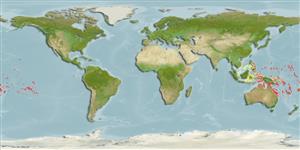>
Ovalentaria/misc (Various families in series Ovalentaria) >
Pseudochromidae (Dottybacks) > Pseudoplesiopinae
Etymology: Pseudoplesiops: Greek, pseudes = false + Greek, plesios = near (Ref. 45335).
More on author: Schultz.
Environment: milieu / climate zone / depth range / distribution range
Ökologie
seewasser riff-verbunden; tiefenbereich 3 - 20 m (Ref. 30874). Tropical; 16°N - 26°S
Pacific Ocean: Mariana Islands, Marshall Islands, and eastern Caroline Islands to the Pitcairn Group.
Size / Gewicht / Alter
Maturity: Lm ? range ? - ? cm
Max length : 3.5 cm TL Männchen/unbestimmt; (Ref. 30874)
Rückenflossenstacheln (insgesamt) : 1; Rückenflossenweichstrahlen (insgesamt) : 27 - 28; Afterflossenstacheln: 1 - 3; Afterflossenweichstrahlen: 17 - 18. SL to 32 mm.
Occurs in inshore reef areas (Ref. 7300).
Life cycle and mating behavior
Maturities | Fortpflanzung | Spawnings | Egg(s) | Fecundities | Larven
Paxton, J.R., D.F. Hoese, G.R. Allen and J.E. Hanley, 1989. Pisces. Petromyzontidae to Carangidae. Zoological Catalogue of Australia, Vol. 7. Australian Government Publishing Service, Canberra, 665 p. (Ref. 7300)
IUCN Rote Liste Status (Ref. 130435)
Bedrohung für Menschen
Harmless
Nutzung durch Menschen
Tools
Zusatzinformationen
Download XML
Internet Quellen
Estimates based on models
Preferred temperature (Ref.
123201): 25 - 29.4, mean 28.4 °C (based on 1249 cells).
Phylogenetic diversity index (Ref.
82804): PD
50 = 0.5020 [Uniqueness, from 0.5 = low to 2.0 = high].
Bayesian length-weight: a=0.01122 (0.00514 - 0.02450), b=3.04 (2.87 - 3.21), in cm total length, based on all LWR estimates for this body shape (Ref.
93245).
Trophic level (Ref.
69278): 3.2 ±0.5 se; based on size and trophs of closest relatives
Fishing Vulnerability (Ref.
59153): Low vulnerability (10 of 100).
Nutrients (Ref.
124155): Calcium = 277 [146, 657] mg/100g; Iron = 1.41 [0.72, 2.52] mg/100g; Protein = 18.8 [17.6, 20.0] %; Omega3 = 0.186 [0.090, 0.399] g/100g; Selenium = 25.5 [10.0, 56.9] μg/100g; VitaminA = 141 [40, 501] μg/100g; Zinc = 3.12 [1.89, 4.84] mg/100g (wet weight);
